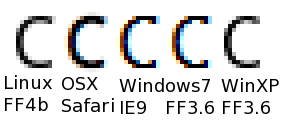Thoughts on Windows 8 Consumer Preview
Microsoft released a "Consumer Preview" of Windows 8 last week, and I thought I'd download it and take a look, as it's the first version of Windows that I've ever had any curiosity about, mainly due to the new Metro UI.
I've only spent a few hours playing around in a fairly aimless manner, so this is by no means a thorough review. In general, I agree with most of the points made in this Orlowski piece at The Register, but this post will cover a few things I found of note.
(Just for background, I'm far from being a Windows aficionado or regular user - whilst I have a desktop, laptop and netbook with Windows 7, those machines spend most of their lives running some form of Linux, whether natively via dual-boot, or in a virtual machine. With regard to the Metro UI, I've never used Windows Phone 7 - in fact, I've only ever seen it being used once in the wild - and I really don't like how it it has been implemented in the latest Xbox 360 dashboard update. In fairness, most of the problems I have with the Xbox 360 implementation are far more to do with how MS have prioritized ads and general media over games, which doesn't have anything do with Metro per se, and would easily be resolved if the dashboard was configurable.)
- I've only tried Win8 in a VirtualBox VM running atop Windows 7. For some reason I'm only able to run it in a limited number of resolutions, none of which are the native resolution of my monitor. Not quite sure whether this is the fault of Win8 or VirtualBox - it's the first time I've used the latter, normally I use VMWare for all my virtualized environments. (In a similar vein, I was unable to get USB memory sticks or external hard drives to be recognized, and I don't know where the fault lies.)
-
The login page confuses the hell out of me. It's super-minimal, which isn't a problem, but most of the time when I click the mouse on the login screen, all that happens is that the screen scrolls up and then back down by about half-an-inch. The same happens if I double-click, long-click, middle-click or right-click. Nothing happens if I hit the Windows key (which is used heavily in Win8, see later point). I've just discovered that pressing the Ctrl key, or rotating the mouse wheel, brings up the password prompt - prior to that point I'd just been randomly moving the mouse around and clicking until I triggered some magical gesture.
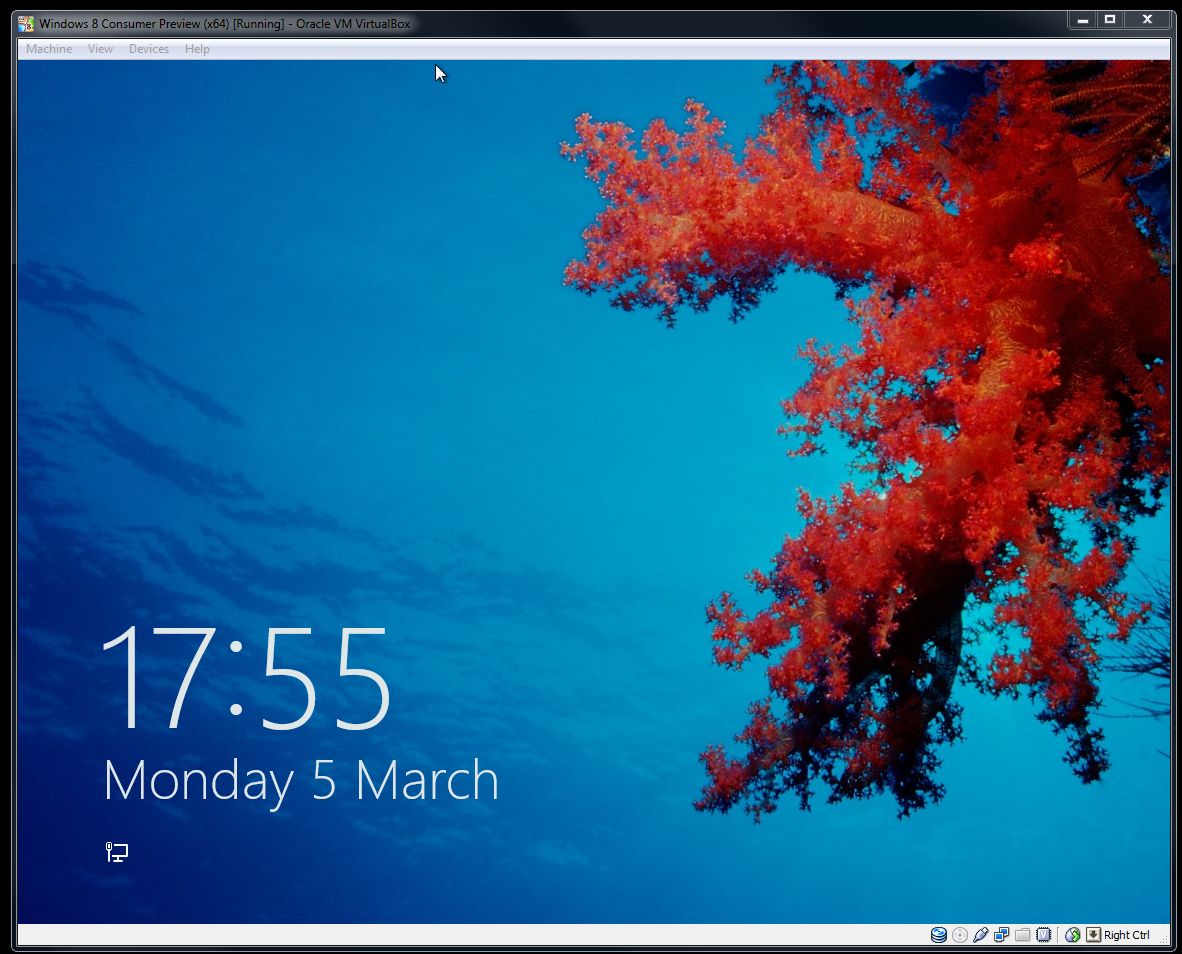
- MS seem to push you towards using authentication based on Windows Live/Hotmail/Microsoft Live/whatever-they-brand-it-this-week accounts. This isn't necessarily a bad idea, but one thing that I'm not a big fan of is that they suggest that people might want to create a Windows account with the same name as their regular email account. From my experience on a project using Google accounts, where we suggested people might want to create a Google account named "joebloggs@hotmail.com" or "fred@myisp.com", this just leads to user confusion, as people mentally associate a particular account with a particular service. (Theoretically the same should apply to stuff like Amazon accounts, but the same issue doesn't really apply for various reasons. Probably something for a different post...)
-
MS seem to be really pushing Metro over the "traditional" Windows UI, but I'm really not sure how it's going to scale. I did a completely clean install, and just added Firefox, Opera, Safari+QuickTime and TortoiseSVN, and already the Start screen is full of crap and has more items than will fit on screen at once:
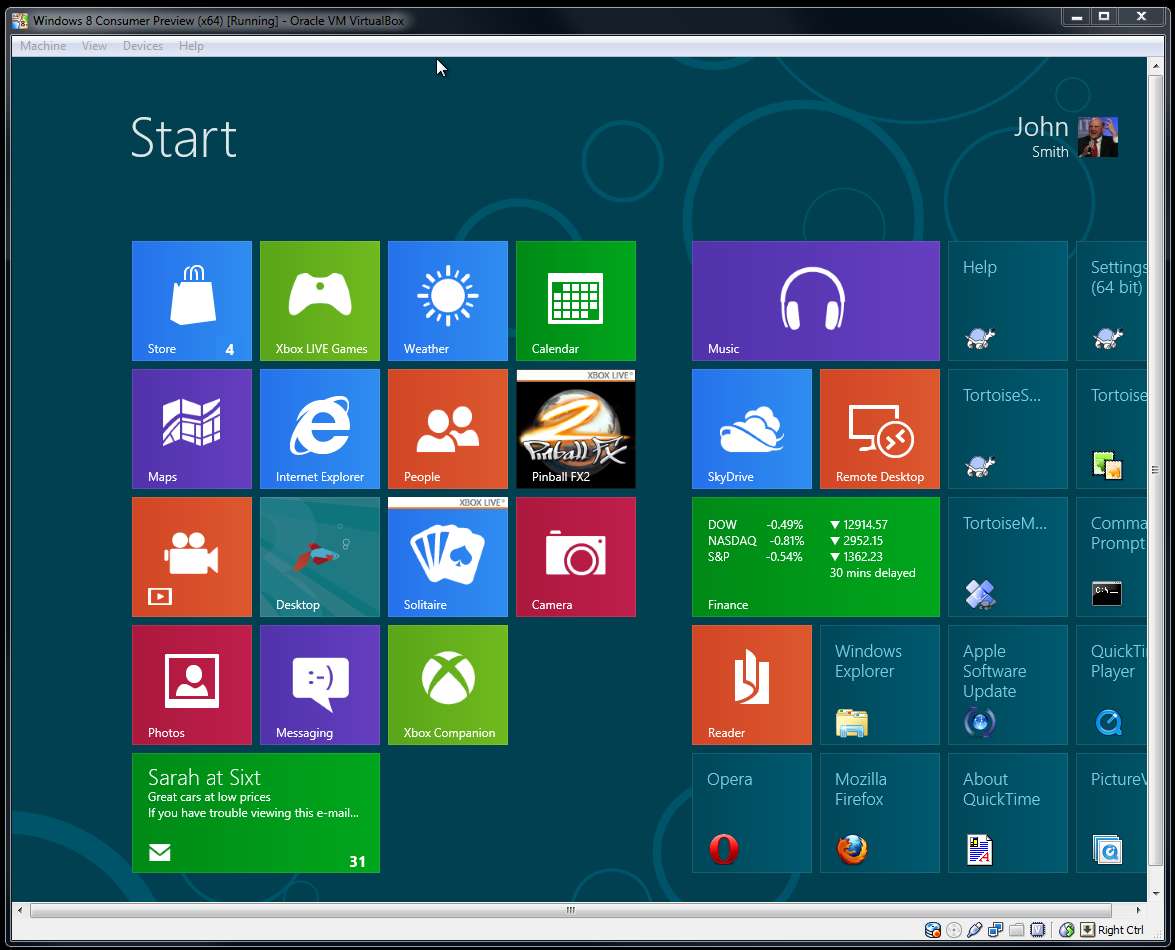 Note that in the above shot, I'd already reduced some of the boxes that default to double width (such as Weather and Calendar) down to single width. I'm not sure why the "packer" automatically moved some items into the space that was freed when I did that, but hasn't moved Music - the items can be manually dragged, but it seems odd that it sometimes works automatically and sometimes not.
Note that in the above shot, I'd already reduced some of the boxes that default to double width (such as Weather and Calendar) down to single width. I'm not sure why the "packer" automatically moved some items into the space that was freed when I did that, but hasn't moved Music - the items can be manually dragged, but it seems odd that it sometimes works automatically and sometimes not.
- That "submenu" items such as those for TortoiseSVN or Apple Software Update have appeared in the top menu seems incredibly lame. Again, they can be manually removed from the Start screen, but (a) I don't know why users should have to manually get rid of all the crap that a newly installed application might have added without asking, and (b) I'm not sure how easy it would be to find/restore such deleted items. (There doesn't seem to be any sort of application specific context menu associated with each box.
- Metro applications launch full screen, and have no window controls. This meant that I was scratching my head trying to work out how to escape from an application. In the end I had to resort to a Google search, and found that (a) I wasn't alone in being confused, and that (b) the answer is to press the Windows key. I imagine the proper version of Windows 8 will have some sort of introductory tutorial that explains this to new users, but I foresee a lot of confused people stood at demo units in PC World wondering what the hell they're supposed to do next...
- By comparison, losing the "start" button in the regular UI is actually less painful than I was expecting - with one caveat. I'm sure that it'll probably be fine on a regular desktop, but as I've had to run Win8 in a VM in a window much smaller than my overall screen, the experience was a tad fiddly.
- One other minor point about Metro pushing the Windows key - MS seem to be very pleased with the new Windows logo they've come up with, and compared to some of the gouge-your-eyes-out rebranding monstrosities that come out, I'd consider it perfectly OK. However, they're up against millions (billions?) of existing keyboards that are sending a very different message about what the Windows logo is. If I had to tech support over the phone to non-technical people such as my parents, I'd expect to have to describe to them what "the Windows key" is, and the first description is "it looks like a flag", which the new logo doesn't.
-
Probably the most useful thing for me in Win8 is having IE10 to test. As yet, I haven't actually used it very much, so I don't know how comparable it is to the rest of the browser market. (Personally I consider IE9 a very weak release, far behind the rest of the pack - probably closer to Firefox 2 than 3. The summary page at caniuse.com agrees with me.) What is a bit odd though, is that in many ways there are two IE8 browsers: the one for the "traditional" Windows UI, and the one for Metro.
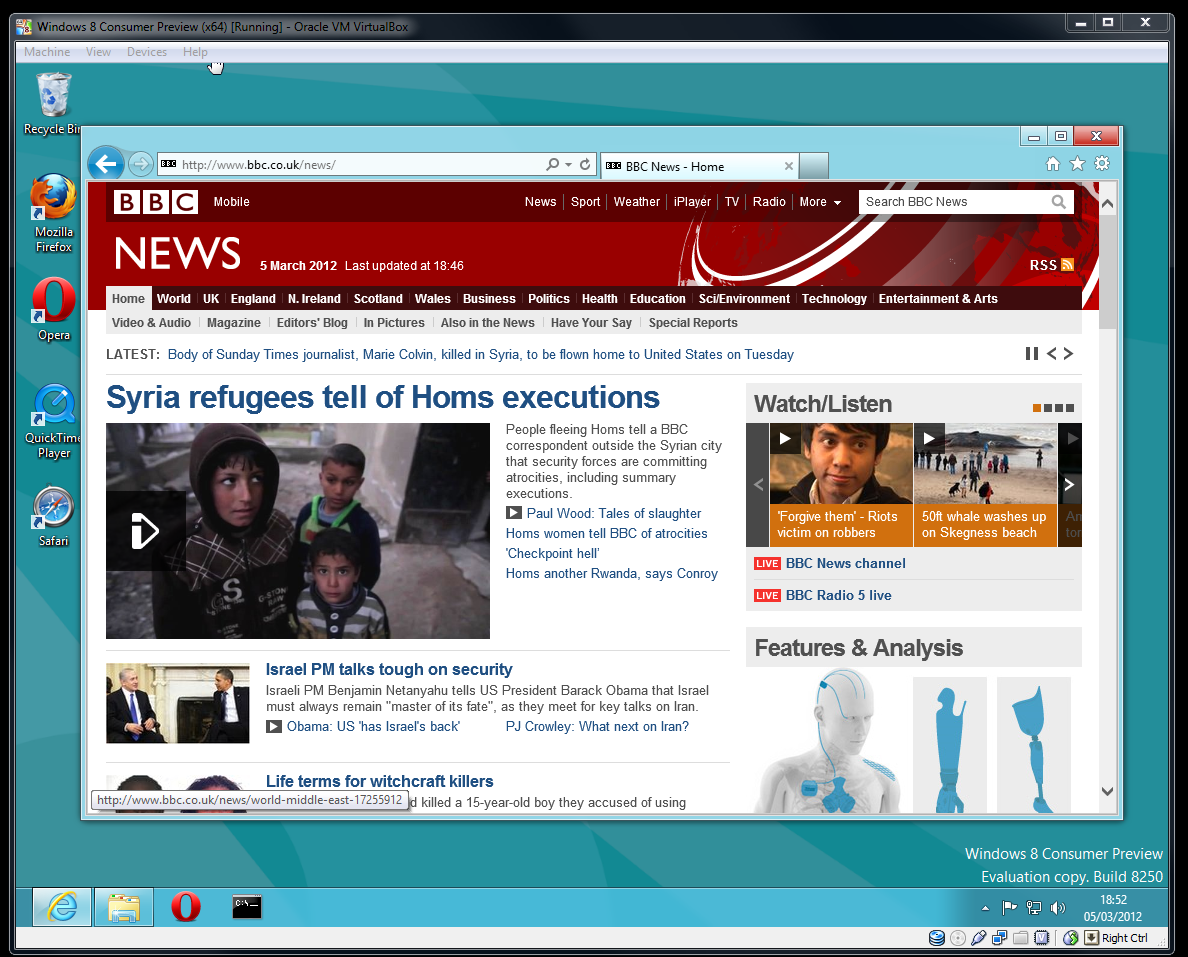 Moving the browser chrome down to the bottom in Metro is a non-issue. Moving the "forward" button to the far right, rather than being adjacent to the "back" button, and losing the "home" & "bookmarks" buttons, are very questionable. But refusing to play Flash content on a machine that has Flash installed and working is absolutely batshit insane.
Moving the browser chrome down to the bottom in Metro is a non-issue. Moving the "forward" button to the far right, rather than being adjacent to the "back" button, and losing the "home" & "bookmarks" buttons, are very questionable. But refusing to play Flash content on a machine that has Flash installed and working is absolutely batshit insane.
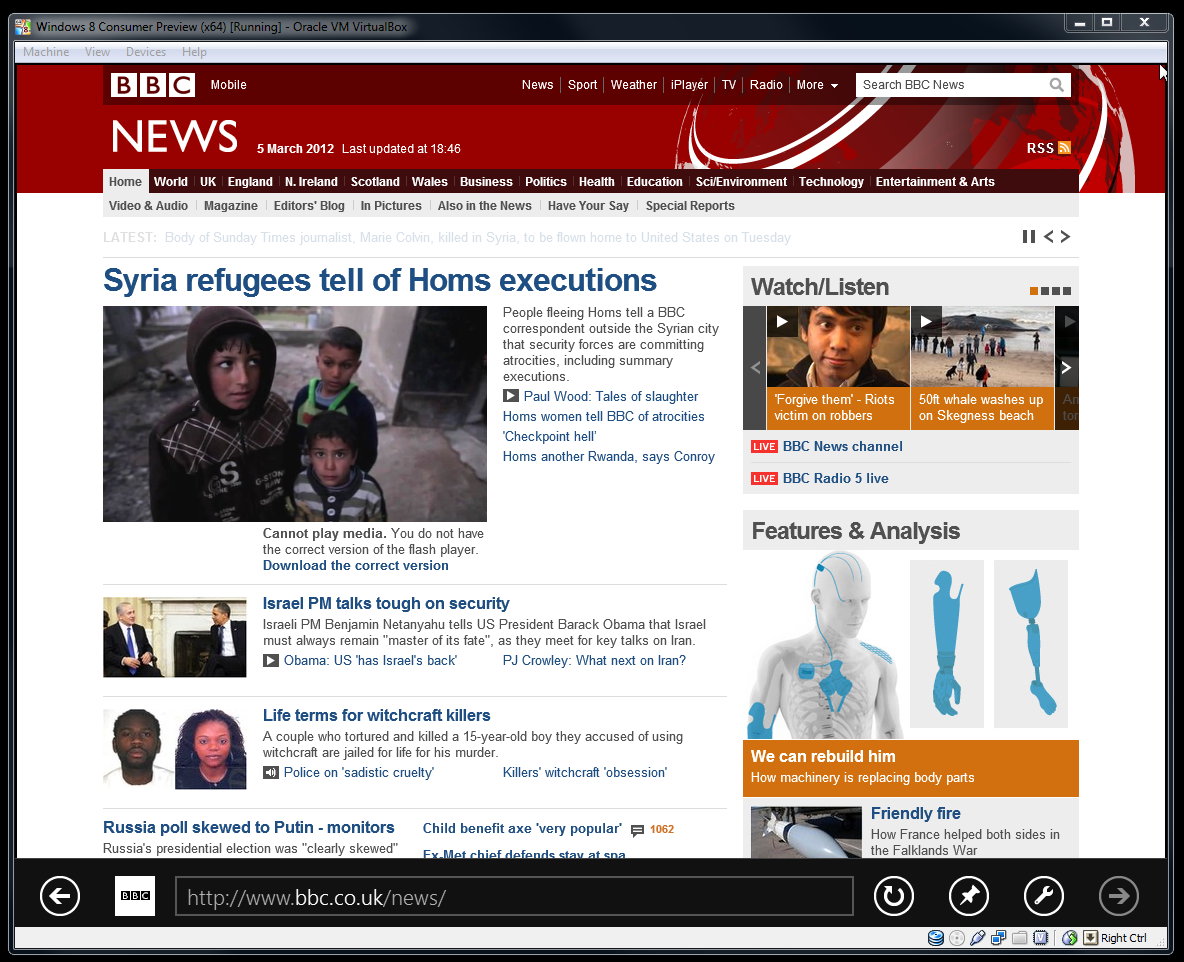 As an avowed Flash-hater, on one level I do want to welcome yet another nail in its coffin. However, this puritanical refusal to do something that the machine/OS/browser is clearly capable of, seems very user-hostile. I was aware that Flash and other plug-ins were not going to be available in some versions of Windows 8, but I'd assumed it was just going to be the ARM/mobile versions, which makes perfect sense. I guess that MS have decided though that they want to try to have a consistent experience across all Metro platforms, which is admirable in some respects. But given the failure though of non-iPad tablets, I would expect the ARM/mobile part of the overall Win8 user base to be a drop in the ocean for the foreseeable future, so making the experience worse for the 9x% of people on desktop/laptop machines just so the tiny fraction of people on ARM/mobile don't feel left out, strikes me as misguided.
As an avowed Flash-hater, on one level I do want to welcome yet another nail in its coffin. However, this puritanical refusal to do something that the machine/OS/browser is clearly capable of, seems very user-hostile. I was aware that Flash and other plug-ins were not going to be available in some versions of Windows 8, but I'd assumed it was just going to be the ARM/mobile versions, which makes perfect sense. I guess that MS have decided though that they want to try to have a consistent experience across all Metro platforms, which is admirable in some respects. But given the failure though of non-iPad tablets, I would expect the ARM/mobile part of the overall Win8 user base to be a drop in the ocean for the foreseeable future, so making the experience worse for the 9x% of people on desktop/laptop machines just so the tiny fraction of people on ARM/mobile don't feel left out, strikes me as misguided.
- There are also a few other "WTF?" things with IE10, that I've not personally experienced, but which are documented here. I do find it telling that that piece is (at best) neutral in tone, whereas Thurrott is normally "rah rah, isn't this great" about the vast majority of stuff that MS do...
- Not that I was expecting anything, but the continued absence of any bread-and-butter tools like ssh or even telnet is very lame. I suppose that they are too Unixy for MS, and they'd rather not let on that there's an alternative to the world of Windows out there ;-)
Obviously, this is just a preview release, and it makes sense for MS to try out new ideas that might not work out, and which they can easily pull in the official release. Certainly Metro looks nice, and feels less cliched than OS X's brushed steel. (Although given that I mostly use Linux and Xfce, and turn off desktop wallpapers, fancy transitions (e.g. compiz) etc, my opinions on aesthetics probably shouldn't be paid too much heed ;-) Personally, it offends me far less than GNOME 3, the 2011 Google redesign, or OS X Lion - but that's probably because I don't have any great investment in the world of Windows. I do think that such radical changes for a product such as Windows are very "brave", but that's a subject I might elaborate on in another post, as this one is already more than long enough.
